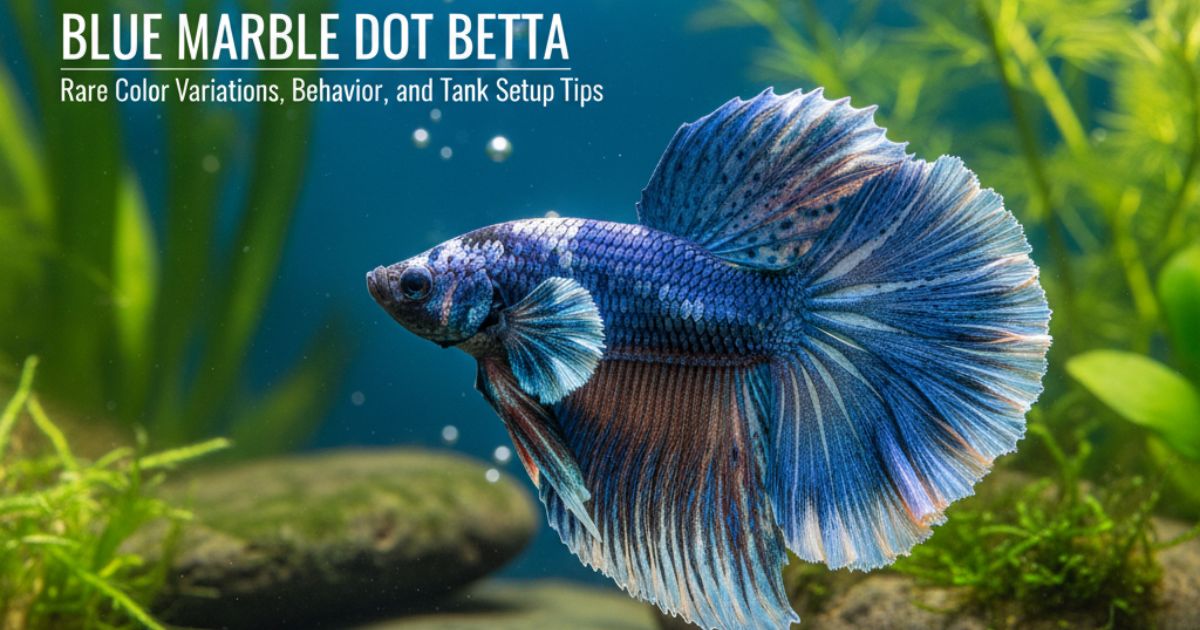If you’re looking for a dazzling fish to brighten up your aquarium, the Blue Marble Dot Betta might just be your new best friend. This unique betta fish is famous for its stunning blue and white marble patterns, dotted with beautiful markings that make each one a living work of art. But there’s more to these little fish than just their looks. Let’s dive into what makes the Blue Marble Dot Betta so special, how to care for it, and answer some of the most common questions fish lovers have.
What Makes the Blue Marble Dot Betta Unique?

Imagine a fish that changes its colors right before your eyes. The Blue Marble Dot Betta is exactly that! Thanks to a special marble gene, their colors can shift and swirl as they grow older. No two Blue Marble Dot Bettas look exactly alike. It’s like having your own ever-changing masterpiece swimming in your tank.These bettas aren’t just about color. They often have a beautiful halfmoon tail that fans out wide when they swim, making them a favorite among aquarium enthusiasts. Their combination of active behavior and stunning appearance makes them a showstopper in any home.
Origins and Popularity of the Marble Betta Varieties

Betta fish have been popular for centuries, especially in Southeast Asia where they originally come from. The marble varieties, including the Blue Marble Dot, have gained popularity because of their eye-catching colors and patterns. Hobbyists love how the marble gene adds a bit of mystery — it’s always a surprise what colors your betta’s marble pattern will turn into!
How Does the Marble Gene Affect Color and Pattern?
The secret behind the Blue Marble Dot Betta’s changing colors lies in its marble gene. This gene causes the fish’s colors to appear in unique, swirling patterns that can shift over time. This means your betta might start off one shade of blue and gradually develop spots or patches of white or even different hues as it grows.
Why Does My Betta’s Color Change Over Time?
Color changes are perfectly normal for this breed, thanks to that marble gene. It’s like their colors have a little magic, changing with the fish’s mood, age, or environment. Don’t worry; it doesn’t mean your betta is sick. Instead, it adds to their charm and uniqueness!
Recognizing the Blue Marble Dot Betta: Key Features
Spotting a Blue Marble Dot Betta among other bettas is all about looking at its patterns and colors. They usually display a mix of deep blues and clean whites, arranged in random dabs or dots across their body and fins. Their halfmoon tails are broad and elegant, making them both graceful swimmers and striking pets.
Differences Between Marble Dot and Other Marble Betta Types
While all marble bettas share the trait of changing colors, the Blue Marble Dot Betta is special because of its distinctive blue shade mixed with white dots and marbles. Other marble bettas might have reds, greens, or even metallic tones, but the blue is especially captivating and popular with collectors.
What Are the Ideal Water Conditions for Blue Marble Dot Betta?
Caring for your Blue Marble Dot Betta starts with giving it the right home. These fish thrive in water temperatures between 75 and 82 degrees Fahrenheit (that’s about 24 to 28 degrees Celsius). It’s important to keep the water clean and maintain a slightly neutral pH between 6.5 and 7.5.Regular water changes and a proper filter will keep your betta’s tank fresh and comfy. Remember, a stable environment means a happy fish with vibrant colors.
How to Set Up the Perfect Aquarium for Your Marble Betta
Your betta’s aquarium doesn’t need to be huge, but it should be just right. A tank of around 5 gallons is a good starting point. Add some live plants or decorations for your betta to explore, but avoid sharp objects that can damage their delicate fins.Keep in mind that these little fish prefer calm waters, so strong filters or noisy air pumps can stress them out. A peaceful tank means your Blue Marble Dot Betta can swim around happily and show off its shiny colors.
Best Diet Choices for Maintaining Vibrant Colors
Feeding your betta well is key to keeping those beautiful colors bright. High-quality betta pellets or flakes packed with protein are a great staple. Supplement their diet with frozen or live foods like bloodworms or brine shrimp – your betta will love the treats!Remember to feed in small amounts 1 to 2 times a day. Overfeeding can harm their health and mess with water quality, which in turn affects their color and energy.
Feeding Schedules and Tips for Betta Health
Sticking to a consistent feeding schedule helps your betta stay healthy and lively. If you follow the “less is more” approach, you’ll reduce waste and avoid water pollution. A fast day once a week can also help keep your betta’s digestive system in check.
Betta Behavior and Temperament
Blue Marble Dot Bettas have interesting personalities. They can be friendly but are also known for their boldness. Male bettas especially like to display their colorful fins when they feel confident or threatened. They might flare their fins at tanks or reflections – it’s their way of saying “this is my space!”
Understanding Marble Betta Behavior and Social Needs
These fish enjoy having a peaceful environment without too many tank mates. While some community fish get along fine with bettas, others might be too aggressive or colorful, triggering stress or fights. It’s best to choose calm and small companions or keep your betta solo to avoid any trouble.
How Do Blue Marble Dot Bettas Interact with Other Fish?
If you’re considering friends for your betta, pick peaceful species that won’t nip at their fins or compete aggressively for food. Avoid other male bettas or brightly colored fish that might provoke fights. Always monitor your tank to make sure everyone behaves happily.
How to Breed Blue Marble Dot Betta Successfully?
Breeding Blue Marble Dot Bettas can be a fun experience but requires some patience. Males build bubble nests on the water surface where females lay eggs. After spawning, the male protects the nest until the fry hatch.Because of the marble gene, young bettas might show a surprising mix of colors, sometimes quite different from their parents. This unpredictability adds excitement to breeding but also means outcomes can vary widely.
Genetic Variations and What to Expect in Offspring
The marble gene is responsible for a wide range of patterns and colors in baby bettas. When two marble bettas breed, the colors and dot patterns in the fry are like a lottery — you never quite know what combination you’ll get! It’s part of the magic that makes these fish very special for breeders.
What Are the Most Common Diseases Affecting Marble Bettas?
Like all bettas, marble bettas can suffer from fin rot, ich, and velvet disease if their environment isn’t kept clean. Watch out for signs like faded colors, clamped fins, or white spots. Early detection and treatment can save your fish and keep your tank healthy.
Preventative Measures and Treatment Options
Regular water changes, proper diet, and avoiding overcrowding are the best ways to prevent diseases. If sickness shows up, many betta-safe medications are available. A healthy environment equals a colorful, lively fish.
How Marble Bettas Became Aquarium Favorites Worldwide
The unique color changes and elegant tails of marble bettas have captured hearts globally. Aquarists prize them not only for their looks but also for their playful personalities. Their magical, shifting colors make every day watching them an exciting experience.
Symbolism and Cultural References
In some cultures, bettas symbolize courage and strength. Their bold colors and spirits reflect tenacity, making them popular beyond just being pets — they inspire admiration and respect.
Seasonal Care Adjustments for Marble Bettas
As seasons change, so do water temperatures, especially in homes without heated tanks. Keeping temperatures steady is important — using aquarium heaters during cold months helps your bettas stay comfortable and healthy all year round.
Innovations in Betta Care You Should Know
New tools like water testing kits and automatic feeders make caring for your betta easier than ever. These innovations help maintain perfect tank conditions and consistent feeding, so your betta stays healthy and colorful without extra hassle for you.
Why Does My Blue Marble Dot Betta’s Color Fade Sometimes?
Color fading can occur due to stress, illness, poor water quality, or age. Don’t panic if you notice this; try checking your tank’s temperature, cleanliness, and diet quality. Often, improving these factors helps your betta regain its vibrancy.
Can Marble Bettas Live Long in a Community Tank?
While possible, it requires careful selection of tank mates and plenty of space. Smaller, peaceful fish that don’t challenge the betta’s territory work best. Otherwise, your betta might become stressed or injured.
Read More:Everything You Need to Know About Butterfly Betta Fish
Why Choose a Blue Marble Dot Betta for Your Aquarium?
Choosing a Blue Marble Dot Betta isn’t just about adding a pet—it’s about adding a living piece of art that changes and grows with you. Their fascinating colors, lively personality, and manageable care needs make them perfect companions for both new and seasoned fish lovers. Plus, knowing you carefully chose a unique and magical fish shows you appreciate beauty in nature unexpected ways.
FAQs
What makes the Blue Marble Dot Betta unique in color and pattern?
The Blue Marble Dot Betta is known for its shifting color patterns, marbling effect, and striking blue dots that create a rare and eye-catching appearance.
How do I properly care for a Blue Marble Dot Betta in a home aquarium?
Care includes warm water, stable pH, gentle filtration, and a stress-free environment to keep their colors bright and behavior healthy.
What tank size is ideal for a Blue Marble Dot Betta?
A 5–10 gallon tank is ideal, giving your Betta enough room to swim while maintaining stable water parameters for better health and longevity.
Do Blue Marble Dot Bettas have special behavior traits?
Yes, they are active, curious, and can display vibrant flaring behavior, especially when kept in a well-structured tank with plants and hiding spots.
How do I enhance the color variations of a Blue Marble Dot Betta?
Provide high-quality protein food, clean water, and low stress—these factors naturally boost color intensity and pattern clarity.
Conclusion
In the end, the Blue Marble Dot Betta isn’t just a fish—it’s a living piece of art with rare color variations, expressive behavior, and endless personality. With the right Betta care routine, a well-planned tank setup, and consistent water quality, this fish thrives beautifully. Whether you’re drawn to its bold marbling, shimmering blue dots, or its lively temperament, this Betta rewards every aquarist with vibrant colors and a captivating presence. Proper aquarium maintenance, thoughtful feeding, and a calm environment ensure your Blue Marble Dot Betta lives a long, healthy, and stunning life.
